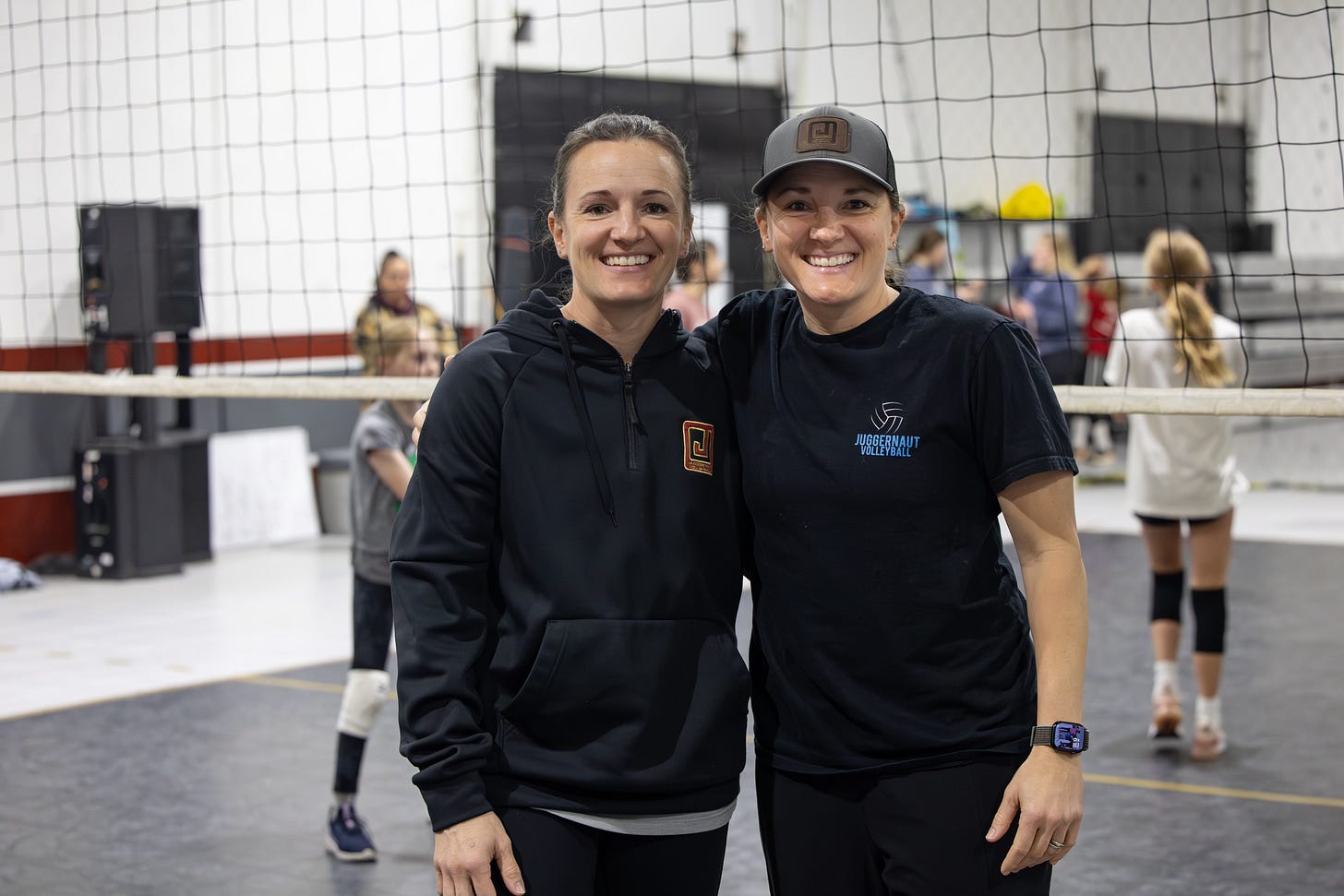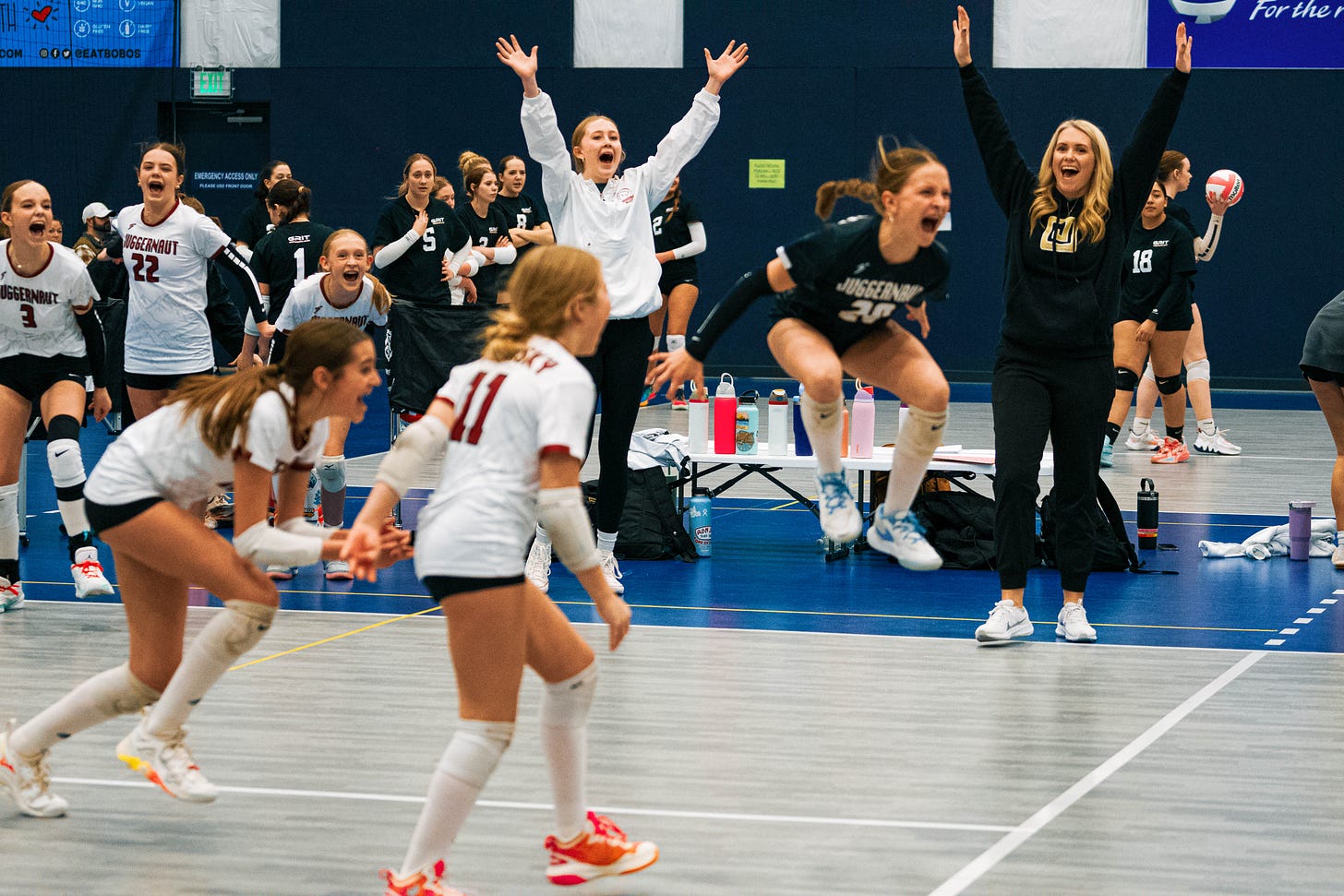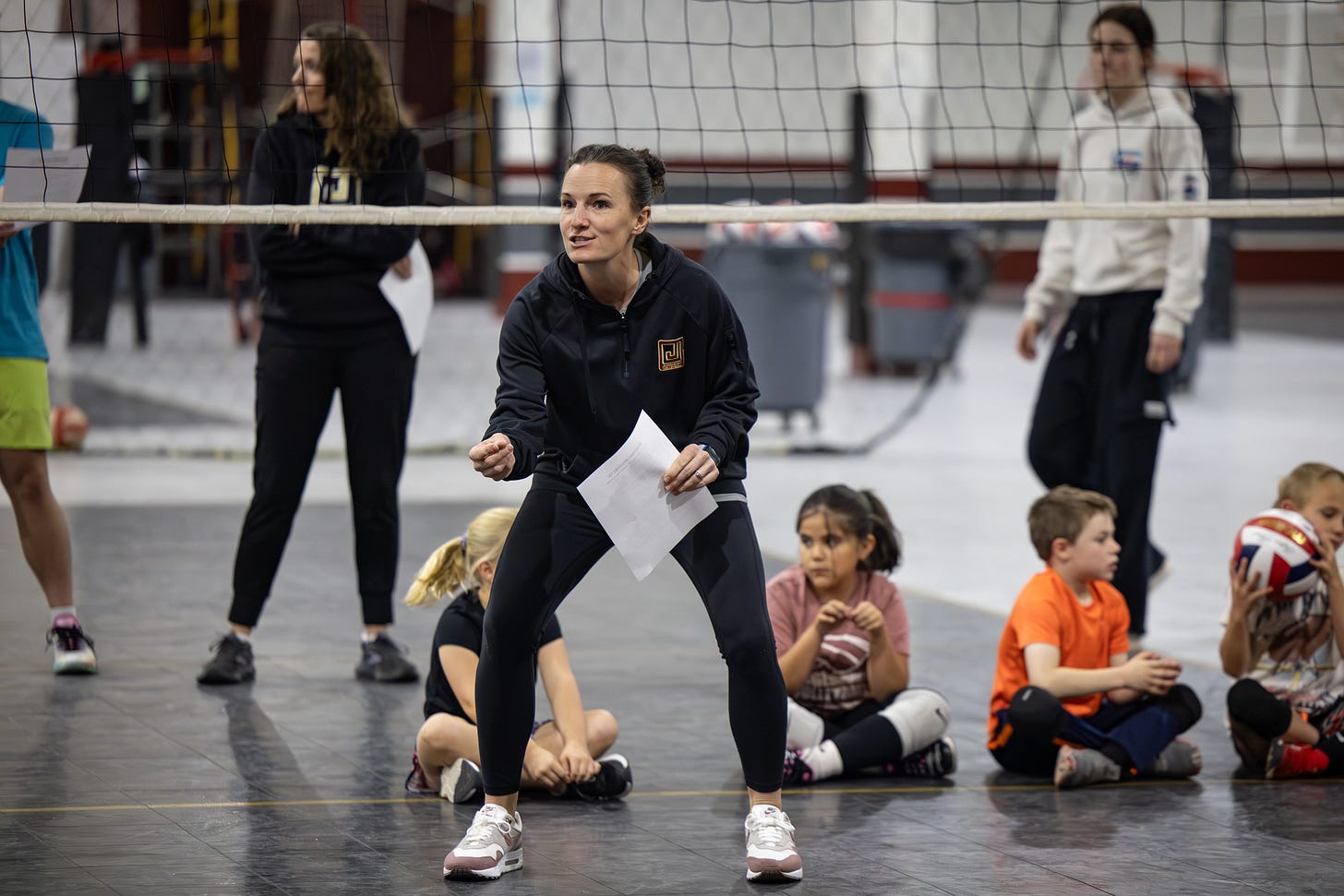Leading a Collaborative Club (part 1)
with Jess Sponenberg and Tarah Olmstead
Jess Sponenberg and Tarah Olmstead are twin sisters who run a youth volleyball club together. That club, Juggernaut, has been around since 2005. While the two weren’t in the same leadership positions they are today, they were part of the group that started the club. They built the club, both literally and figuratively, and are now co-owners and co-directors. I’ve known them since the club began and I’m in awe of how much they, and their club, have grown and changed in that time. Their love for their club, the sport, the players, and the coaches is palpable when you talk to them. Their passion for their work and for the people they work with is truly inspiring.
When I sat down with Jess and Tarah recently, the plan was to discuss one of Jess’ favorite drills for the Drills in Depth series. But that plan didn’t survive for very long, as our conversation kept turning towards how the two coach/club directors work with the coaches and athletes in their club. One of the big goals of Drills in Depth is to highlight the magic in a coach’s behaviors that makes a drill work, rather than send the message that there is something magic in the drill itself. My conversation with Tarah and Jess reminded me that sometimes, instead of talking about drills, it’s better to just talk about the decisions coaches make and the behaviors that result from those choices.
When Tarah and Jess started at Juggernaut, neither had much coaching experience and the club was run very differently than it is today. The sisters, too, are very different than they were then. Tarah still characterizes herself as a bit of a control freak, but much less so than she used to be. She has worked hard, especially in the last few years, to create space for coaches and players in the club to grow rather than dictate how and when growth is expected to happen. Jess sees some of those same control issues in herself and now recognizes that, for her, needing that amount of control over coaches and athletes isn’t sustainable for her or for the club. Now, she talks about the importance of proverbially teaching people to fish instead of giving them fish. Both of them realized that, in order to ease their concerns about control, they needed to work on their ability to trust the coaches they worked with. They needed to feel that things would be okay in the gym when they weren’t there. For them, there was more to this than just taking some deep breaths and repeating a mantra about letting go. They needed to change not just how they functioned, but also how the club functioned.
Tarah and Jess, true to their meticulous fashion, identified the problems that gave rise to their difficulty trusting. They realized that the most important product of their club was the interactions players and families had with coaches. If Jess and Tarah were going to trust the coaches in the club, they needed to trust that those interactions would be positive and would communicate the values of the club. In the club’s early days, there were more teams than there were coaches, so it was difficult to get the same interactions the sisters value so much now. But developing those interactions wasn’t a matter of just changing the player/coach ratio.
Today, Jess interviews all prospective coaches and, more importantly, gets them into the gym as soon as possible. Prospective hires shadow during practices and clinics and are also given opportunities to participate, including giving feedback. Coaches can then give the prospective hires feedback so they begin to learn how the club works and what the club values. Jess told me that she’s had interviews that were very promising but she could tell within five minutes of being in the gym the prospect wouldn’t be a good fit in the club. Conversely, she’s also had interviews that were less impressive but the prospect really shone once they started actually coaching.
Being more thorough in their hiring has really helped the sisters feel more confident in who they hire. This has ultimately led to better cultural fits, which in turn has led to better coach retention. As they’ve grown to trust the coaches more and more, they recognize coaches, like teachers, are far undervalued so the twins haven’t been afraid to invest more in the coaches financially as well as offering them more support in other ways. As Jess told me, “whatever it takes for you to be an A+ coach out there.”
Keeping more coaches longer helped the club offer a more consistent product. Jess described it like a school system in which the same people teach sixth grade for years. The seventh grade teachers know what those teachers do and, therefore, they know what to expect of the students they receive from them each year. Not only is this consistency beneficial for the coaches in the club, it is beneficial for the players and families. They, too, can form expectations of what will await them in their coming years.
To demonstrate the importance of consistency and retention in a business that rarely rewards such things, the club has a “lifers” award that is given to players who are members of the club for at least five years. They also created an alumni tournament, in which former players return for an evening of play amongst themselves, as well as against the top teams in the club. This tournament helps players feel connected to the club, even after they finish playing there. Along with their efforts to retain coaches, these actions show how much Jess and Tarah value community. As Jess said during our conversation, “we have a team and I wouldn’t do it any other way.”
But you can’t just pay and award your way to community. Building community and continuity means building something that people want to be part of, want to come back to, and see themselves growing in. Jess talked about how, as a coach, she might be able to create those feelings in ten athletes each season but, as a lead coach, she could create those feelings in ten coaches each season, meaning that the impacts could ripple out to 100 players. So, even though she is still regularly involved in on-court coaching of players, much of her work is now centered on working with coaches. Tarah, on the other hand, still coaches a team (“I’m not ready to give that up yet,” she told me) but she also functions as a lead coach for the club’s youth teams.
Jess and Tarah are “lead coaches” in the sense that they lead from the front, so they’re not just administrators or coach developers. Both still spend much of their work time in the gym with coaches and players. Additionally, the twins feel that reflection and reevaluation is vital throughout the season so most practices begin with time for observations and reflections on how things are going from directors, coaches, and even players. They build off those observations by immediately moving onto demonstrations of the practice’s main training elements and drills so everyone can see the connection between what they just discussed and what they’re about to do.
There are many places in the club volleyball world in which “lead coaching” means being in control of all aspects of planning and execution of practices, but that’s not how Jess and Tarah run things. “I don’t like being in charge of everyone else’s success,” Jess said. The sisters, instead of planning out everything for each team, create practices that have some common aspects for all teams but also have spaces that coaches fill on their own or in collaboration with Tarah and Jess. But this way of planning and collaborating is built on more than it appears at first.
In part 2, I’ll describe more about how the twins manage the club to facilitate collaboration.
Leading a Collaborative Club (part 2)
🚨 I’m presenting a webinar this week for the AVCA. You can register here. 🚨
If you have questions or comments you can email me or you can email Jess or Tarah directly.






